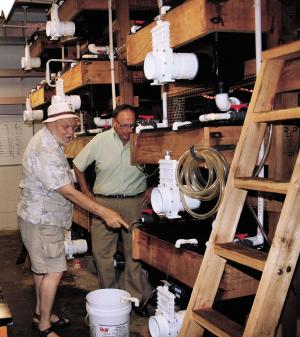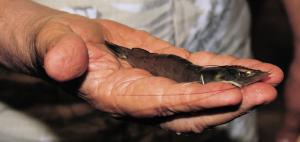2012 - Volume #36, Issue #2, Page #08
[ Sample Stories From This Issue | List of All Stories In This Issue | Print this story
| Read this issue]
Shallow Water Indoor Shrimp Farm
 |
 |
“Putting shrimp production inside gives you complete control of light and temperature,” says Addison Lawrence, professor, AgriLife Research Mariculture Laboratory (ARML), a Texas A&M research facility. “You also have complete biosecurity so you decrease potential disease concerns.”
The freshwater system eliminates concerns over shrimp pulled from polluted water. Lawrence notes that most shrimp eaten in the U.S. are produced in Southeast Asia and frozen anywhere from 2 to 4 times. He adds that shrimp grown in open ponds require antibiotics sometimes banned in the U.S. Domestic shrimp farmers can’t compete with the multi-crops per year of tropics-based producers.
Lawrence says that all changes with his prototype system that has four columns of raceways stacked four high, with an average water depth of 5 to 7 in. Baby shrimp are started in the top level raceway and move downward as they grow. The shallow water system makes stacking possible, and that gives Lawrence the economic potential needed to justify the investment.
“A domestic producer with traditional ponds can harvest around 20,000 lbs. of shrimp per acre,” says Lawrence. “Properly run, our system can produce up to a million pounds of shrimp per acre.”
ARML is the oldest shrimp research facility in the country, and Lawrence has worked on aquaculture systems for 50 years. “The most difficult aspect of developing this system was proving shrimp could actually produce in shallow water levels,” he says.
Lawrence hopes the first production-scale system will be started within 12 months. The system and technology have been licensed to Royal Caridea in the U.S.
“It’s difficult to determine how much the system can be downsized as economy of scale is affected by the margin per pound produced,” says Lawrence. “If a farm has an outstanding marketing program, it has a good chance of success.”
Contact: FARM SHOW Followup, AgriLife Research Mariculture Laboratory, 1300 Port Street, Port Aransas, Texas 78343 (ph 361 749-4625; smpall@yahoo.com); or Royal Caridea, LLC, 603 S. Mays St., Round Rock, Texas 77864 (ph 916 616-7038; Meese404@gmail.com).

Click here to download page story appeared in.

Click here to read entire issue
To read the rest of this story, download this issue below or click here to register with your account number.




